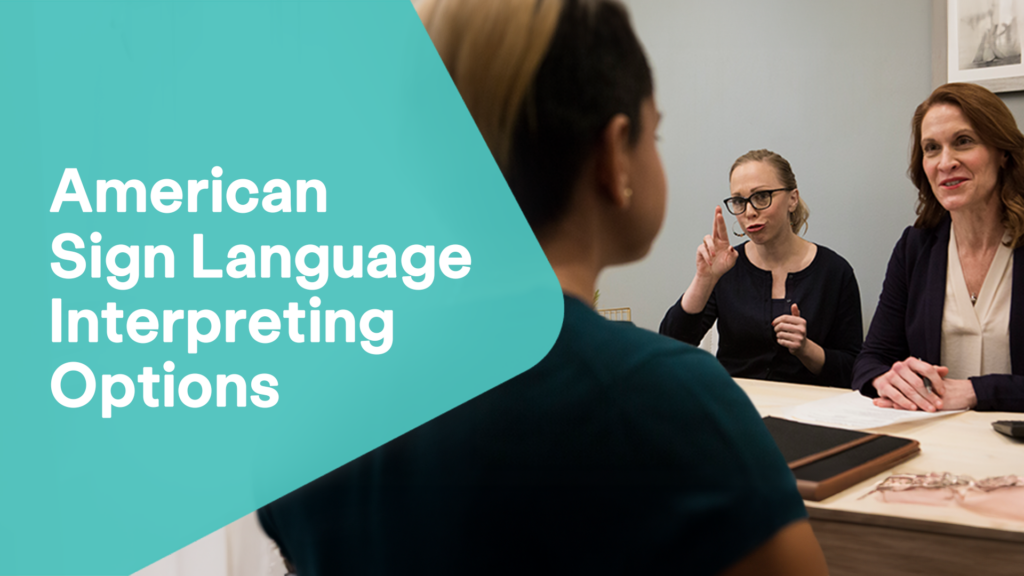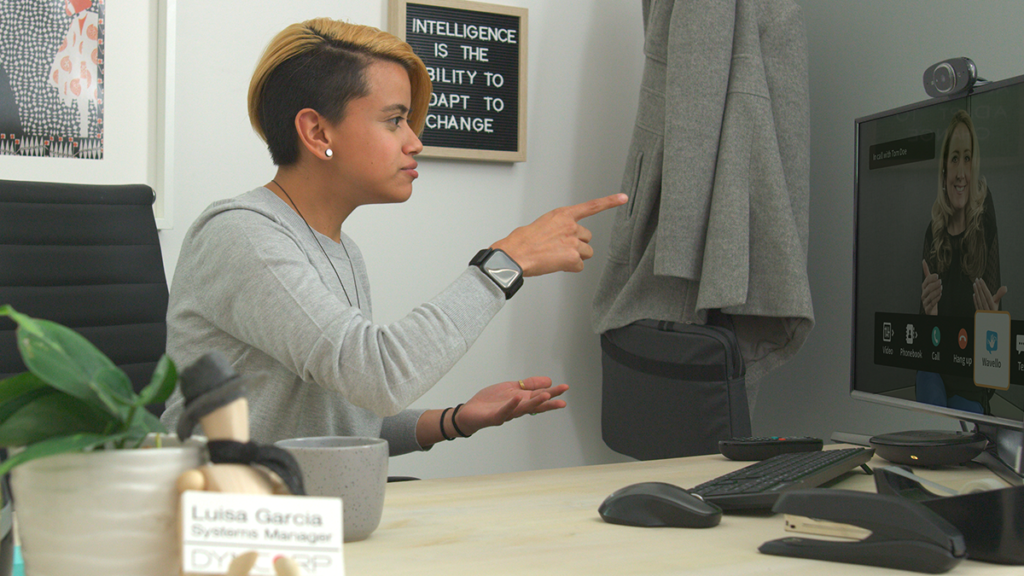
American Sign Language Interpreting Options
Providers of sign language interpreting may offer several different solutions, all with different use cases, each with their own benefits. When considering which interpreting solution to choose, it is important to consider these uses and benefits. The major solutions are:
Common interpreting needs
This is a different categorization than the types of interpreting need — such as education, legal, healthcare, retail, governmental, financial, or enterprise.
All interpreting requires fluency in the sign language and spoken language of the Deaf and hearing participants in the conversation. In the United States, this is American Sign Language (ASL) and usually spoken English, but there’s increasing demand for spoken Spanish.
Interpreting vs translation
Interpreting solutions are different from translation. Many people use “interpreter” and “translator” interchangeably, but they are distinct roles. An interpreter works with the spoken word, converting speech from a source language into a target language. A translator works with the written word, converting text from the source language to the target language. This includes translating from the written word to a signed language.
Both interpreting and translating consider the style and tone of the message content as well as taking into account differences in culture, dialect, and setting. With few exceptions, translators typically work only in one direction at a time while interpreters usually work in both directions. (1)
On-site interpreting
On-Site interpreting (also called in-person interpreting or face-to-face interpreting) means that the Deaf person, hearing person, and interpreter are all at the same location. One example of when this is the best choice is when all three parties are moving around, such as a new employee tour or a healthcare facility where patients need interpreting in multiple locations (reception, triage, exam room, etc.).
Other examples are:
- Academic or conference-type environments where multiple people may be speaking
- Legal situations, such as court or contract signings
- A team dinner at a restaurant
- Job interviews where all parties are local

You may also choose on-site interpreting when your location does not have an internet connection or video conferencing equipment for VRI.
Questions that often come up regarding on-site interpreting:
Why do agencies charge for a required minimum time (generally two hours) or some sort of appearance fee for on-site interpreting?
On-site interpreters generally have appointments throughout the day for different people at different locations. They may start with a 9:00 appointment at one location then have subsequent appointments at multiple different locations.
The interpreter must travel to each location so they can’t follow that first 9:00 appointment with one immediately afterwards at 9:30 — that is logistically impossible. As a result, their scheduling must allow for travel as well as their time and service.
Scheduling in larger blocks of time also allows for the interpreter to be available for communication outside the actual appointment. While it may seem easy to calculate how long to schedule an interpreter for a medical appointment, for example, people frequently only consider the actual appointment itself. It is easy to forget to account for things like the interpreter and the client meeting prior to the appointment, the check-in with reception, staff calling the patient in and checking health history and preliminary testing, plus other necessary tests (bloodwork or x-rays for example) outside of the actual doctor/patient meeting. Additionally, there are often unexpected delays which could happen at any stage of the visit. In this way, a simple 20 minute appointment actually requires the interpreter for much longer.
Why do agencies sometimes send more than one interpreter?
Sign language interpreting is a mentally and physically taxing job. No matter how expert the interpreter is, after a long period of continuous interpreting, they will become mentally exhausted and unable to fully focus on the work of interpreting cultural and linguistic information between two languages. As a general rule, interpreters should have regular breaks of half the time they are present. (2) As such, the agency schedules two or more interpreters if the situation calls for continuous interpreting for a long period of time.
Video Remote Interpreting
Video Remote Interpreting (VRI) is a flexible solution for in-person or virtual conversations with an interpreter over video, which makes it appropriate for a range of use cases.
Just like on-site interpreting, one of the users — usually a business or organization — has a contract or account with a VRI provider for scheduled VRI, on-demand VRI, or both.
Scheduled VRI
Scheduled VRI is ideal for a pre-scheduled meeting — either online via any of the videoconferencing platforms such as Zoom or Google Meet with both the Deaf and hearing people in the same location and the interpreter in a remote location.

Some examples of pre-scheduled meetings are:
- interviews
- meetings with employees
- parent-teacher conferences
- doctor’s appointments
The interpreting agency assigns either an individual interpreter or a team of interpreters, depending on the length and complexity of the meeting. A significant benefit of scheduled VRI is the ability to consider the subject matter of the meeting when selecting interpreters and provide background information to prepare for the appointment. The user may even have a list of preferred interpreters the provider will attempt to assign when possible. This ensures the meeting has the appropriate interpreters for the users’ needs and, when possible, preferences.
On-demand VRI
On-demand VRI is the best solution when there is an unscheduled need, such as an emergency meeting or impromptu conversations. The VRI provider gives the user a contact number or app for a tablet, mobile device, or computer with a camera. In some situations, the VRI provider loans the user the equipment itself.

Some examples of use cases for on-demand VRI include:
- unscheduled interviews, employee meetings, doctor’s appointments
- walk-in visits to retail and hospitality businesses
- pharmacies
- utility offices
- government services such as police, fire, and EMS as well as the DMV or Department of Workforce Services
On-demand VRI is generally first-come, first-serve. The user may get an interpreter immediately or there may be a waiting time until one is available. Either way, they get the interpreter that is next up from the pool of available interpreters.
This method of getting an interpreter quickly is sufficient for most situations. However, this has some limitations. On-demand VRI is best for quick conversations. If a meeting goes long, the interpreter may need to take a break and get another interpreter to take over; if the subject is complicated or has a lot of context dependencies, the new interpreter may take a few moments to get necessary context.

In addition, not every interpreter has the same experience level with the specialized language of law, medicine, or technical fields. The option of having a smaller pool of interpreters with this specialized experience to answer the calls from a particular user may be something the interpreting agency can arrange. But consider whether the need is great enough to accept the tradeoff of possible longer wait times to get an interpreter from that smaller pool.
Specialized interpreting
Some situations require specific training and education and may require additional certifications. These situations highlight an advantage of using an established industry leader like Sorenson. With the largest private interpreting workforce in the world, Sorenson employs qualified interpreters for the full range of specialized needs.
Legal interpreting
Legal interpreting requires knowledge of law, protocol, and training in interpreting strategies unique to legal situations. These include court and law enforcement proceedings where matters involving high-risk and personal freedoms are often the focus(3).
States may require either a specific level of certification(4) or have a process for qualifying, or both(5). When talking to interpreting agencies, ask them if they have sufficient numbers of interpreters who already meet those criteria to cover the need.
This type of interpreting is in high demand due to the breadth of the legal field. It includes law enforcement investigations, interviews and interrogations, client-attorney interactions, and a wide range of court and legal proceedings(3).
Medical interpreting
Medical interpreters must be familiar with various medical interpreting requirements.
These include:
- when they may or may not be in the room with the patient
- where they must stand to preserve the patient’s physical privacy (in the case of an ob-gyn exam, for example)
- any legal requirements (HIPAA, ADA, etc.)
- any special considerations for mental health situations(6)

In some situations they also may need to have specific immunizations or wear clothing similar to medical professionals to maintain sterile conditions, such as in an operating room.
When discussing your needs with the interpreting agency, think about if your practice or facility would expose interpreters to any such situations. If so, tell the interpreting agency up-front so they can make sure their interpreters prepare with any additional immunizations and necessary training.
Interpreting for government
While interpreting for government agencies may not often require specialized knowledge, these agencies often deal with highly confidential information and may require interpreters to pass the agencies’ own background and security checks. This can be a long process that sometimes repeats at regular intervals for renewal. Interpreting agencies such as Sorenson that frequently contract to interpret for government agencies maintain a pool of interpreters who have passed these checks.
DeafBlind and low-vision
Some Deaf people are also either Blind (DeafBlind) or legally blind or close to it (low-vision). Those situations call for interpreters with training in signing for people with limited vision or other ways of conveying information.
A DeafBlind client, for example, rests their hands on the interpreter’s hands to “see” the signs so the interpreter needs to know how to adjust their signing. This may include signing “smaller” — not moving their hands too far away from their body. The interpreter also needs to know the appropriate way to show the emotion of the message without using facial expressions.
A client who is not DeafBlind but is low-vision may need the interpreter to sit or stand close and sign smaller so the signs do not go out of their range of vision.
Certified Deaf Interpreting
Education opportunities and early language access remain a challenge for many Deaf individuals. Because of this, there likely are Deaf people who, through no fault of the hearing interpreter, do not have the ASL vocabulary level or world experience context to understand the interpreted message. In that situation, a Certified Deaf Interpreter (CDI) is a great option. The CDI is a communication specialist, working with their hearing team to use their native language abilities and in-depth understanding of Deaf communication dynamics to tailor the message so the Deaf person will best understand the message.
How does this work? The CDI typically briefly meets with the Deaf client just prior to the appointment (15 minutes before) to assess their communication needs. During the appointment, the hearing interpreter and the CDI work together to adjust the message and make it specific to the Deaf client. During the appointment the CDI will utilize different strategies to maximize the Deaf client’s understanding of and full participation.
Common CDI Needs
An example that many may be familiar with is government update broadcasts, increasingly seen with interpreters, such as emergency updates such as those during the COVID-19 pandemic. Those interpreters are usually CDIs, working to ensure the message can be understood by most Deaf people while off-camera, there is a hearing interpreter team “feeding” them the news verbatim for them to adapt and present directly to the camera.
CDIs are especially in demand for medical or legal situations where it is critical for the Deaf client to have full, unequivocal understanding of information/choices and full participation in decision making.
Trilingual interpreting
Some situations call for interpreters who know multiple languages. In the United States, the most common need is for those who are fluent in English, Spanish, and ASL due to the large number of immigrants from Latin America. Like CDIs, these interpreters are in demand for general, legal, medical, and government situations.
Video Relay Service
Video Relay Service (VRS) is a no-cost, subscriber-based service for Deaf people who use ASL. It provides interpreting services via videophone calls using ASL and spoken English or Spanish. VRS rules require that the Deaf person, hearing person, and interpreter all must be at different locations. It’s part of the Telecommunications Relay Service (TRS) program as a provision under the Americans with Disabilities Act (ADA) of 1990.

You can find more information on VRS and how it works in our “What is Video Relay Service (VRS)?” post.
Who can be an ASL interpreter?
To work professionally as an ASL interpreter, the interpreter learns not only American Sign Language but also Deaf culture. They learn how to correctly relay signed and spoken information back and forth between the Deaf and hearing people in the conversation, including how to account for dialects, settings, and more.
Naturally the question then arises, can someone hearing or Deaf be an ASL interpreter. The answer is both can be interpreters. Deaf interpreters are their own category – Certified Deaf Interpreter (CDI). CDIs specialize in communication with Deaf individuals who need enhanced access to participate fully.
Choosing an interpreter with the right qualifications
For most people searching for interpreting services, many agencies remove the burden of verifying an interpreter’s credentials by checking those credentials themselves. When contracting with an interpreting agency, you should ask them if they do this.
Continuing education is critical to the profession and ensures that interpreters develop in-demand skills.
- The RID provides further professional development courses through Continued Education Units (CEUs) so interpreters can maintain their certification or qualify for advanced certification as well as stay up to date on industry trends or changes such as signs for new terms in different industries.
- Sorenson Communications not only provides CEU training to the ASL interpreting community but also provides the most comprehensive interpreting training and development program in the world to upskill interpreters for all types of interpreting scenarios through its in-house training department.
Which Type of Interpreting to Choose?
So, you need at least one of these services but aren’t sure which? It can be an overwhelming decision, whether your company is searching for accessibility services for employees, clients, or customers, or if you are a Deaf person trying to help others contract for these services.
Simply contacting a local interpreting agency does not always get the direction you need. Many agencies specialize in one type of interpreting, usually on-site interpreting. Sorenson not only offers a full range of types of interpreting, it also offers Design Consultants. These are people with in-depth knowledge of the Deaf community, ASL interpreting, and accessibility who can guide you in identifying the most appropriate services for your needs.
Sources:
- https://www.atanet.org/client-assistance/translator-vs-interpreter/
- https://www.languagescientific.com/one-interpreter-or-two/#:~:text=Interpreting%20is%20mentally%20taxing.,schedule%2C%20TWO%20interpreters%20are%20needed
- http://www.interpretereducation.org/specialization/legal/
- https://ncdhh.nebraska.gov/content/functional-descriptions-interpreter-levels
- https://www.utcourts.gov/en/court-records-publications/resources/court-interpreters/asl.html
- http://www.interpretereducation.org/wp-content/uploads/2015/02/DomainsCompetencies10-09-08.pdf

